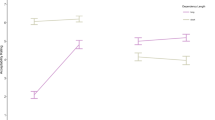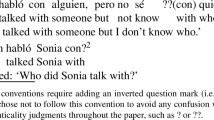Abstract
The notion of island repair in ellipsis constructions has received much attention. Existing analyses typically suggest that in island repair contexts, an element undergoes movement, inducing an island violation, and then the violation is removed by deleting the portion of the structure that contains the island. It has been observed that island violations do not arise in the Fragment Answer construction in Korean, whose derivation has also been argued to involve movement and deletion. In other words, the construction also manifests the island repair phenomenon. In this paper, I explore an alternative analysis of the absence of island effects in Fragment Answers in Korean without appealing to the notion of island repair. Assuming the movement and deletion analysis, I argue that the absence of island effects in the construction in question is a consequence of the interaction between two independently motivated processes, i.e., Pied-Piping in the sense of Cable (Linguist Inq 41:563–594, 2010a, The grammar of Q: Q-particles, wh-movement, and pied-piping, Oxford University Press, New York, 2010b) and Extra Deletion in the sense of An (J East Asian Linguist 25:313–350, 2016a). The gist of the proposal is that in the relevant contexts, instead of allowing illegitimate extraction from an island, the whole island itself undergoes movement and is subsequently reduced by deletion, leaving the focused phrase on the surface, which induces the façade of island repair. I also show that the current analysis straightforwardly accounts for a parallelism among constructions that are quite different in nature, i.e., Fragment Answers, gapless Right Dislocation, and Right Node Raising, which cannot be captured by existing approaches to the respective constructions. Thus, the parallelism provides strong evidence in support of the alternative analysis of island repair proposed in this paper.
Similar content being viewed by others
References
Abe, Jun. 2015. Two types of Japanese right dislocation under the bi-clausal analysis. Presented at the 11th Workshop on Altaic Formal Linguistics, University of York. June 4.
Abe, Jun. 2016. Against the “repair by ellipsis” approach: The case of Japanese multiple Right Dislocation. Presented at the 18th Seoul International Conference on Generative Grammar, Sogang University. August 5.
Ahn, Hee-Don. 2012. A study of fragments: Focusing on English and Korean. Seoul: Hankuk Munhwa.
Ahn, Hee-Don, and Sungeun Cho. 2012. On caseless fragments in Korean. Studies in Modern Grammar 70: 25–47.
Ahn, Hee-Don, and Sungeun Cho. 2017. On caseless fragments and some implications. Language Research 53: 247–286.
An, Duk-Ho. 2007. Syntax at the PF interface: Prosodic mapping, linear order, and deletion. Ph.D. dissertation. University of Connecticut, Storrs.
An, Duk-Ho. 2009. A note on genitive drop in Korean. Nanzan Linguistics 5: 1–16.
An, Duk-Ho. 2013. What is not NP-ellipsis in Korean. In Deep insights, broad perspectives: Essays in honor of Mamoru Saito, ed. Yoichi Miyamoto, Daiko Takahashi, Hideki Maki, Masao Ochi, Koji Sugisaki, and Asako Uchibori, 22–41. Tokyo: Kaitakusha.
An, Duk-Ho. 2016a. Extra deletion in fragment answers and its implications. Journal of East Asian Linguistics 25: 313–350.
An, Duk-Ho. 2016b. The parallelism among fragment answer, right dislocation, and right node raising constructions and its implications. Presented at the 6th Workshop on Comparative Syntax and Language Acquisition. Nanzan University, Nagoya. December 10.
An, Duk-Ho. On certain adjacency effects in ellipsis contexts. Linguistic Inquiry (to appear).
Barros, Matthew, and Luis Vicente. 2011. Right node raising requires both ellipsis and multidomination. University of Pennsylvania Working Papers in Linguistics 17: 1–9.
Cable, Seth. 2010a. Against the Existence of Pied-Piping: Evidence from Tlingit. Linguistic Inquiry 41: 563–594.
Cable, Seth. 2010b. The grammar of Q: Q-particles, wh-movement, and pied-piping. New York: Oxford University Press.
Choe, Jae W. 1987. LF movement and pied-piping. Linguistic Inquiry 18: 348–353.
Chung, Daeho. 2012. Pre- vs. post-verbal asymmetries and the syntax of Korean right dislocated constructions. Studies in Generative Grammar 22: 703–721.
Fox, Danny, and Howard Lasnik. 2003. Successive cyclic movement and island repair: The difference between sluicing and VP ellipsis. Linguistic Inquiry 34: 143–154.
Hong, Yong-Tcheol. 1994. Ywunghap ilonkwa kyekcosa pwunpho (Incorporation theory and the distribution of case markers). Studies in Generative Grammar 4: 1–43.
Horvath, Julia. 2007. Separating “focus movement” from focus. In Phrasal and clausal architecture, ed. S. Karimi, V. Samiian and W. Wilkins, 108–145. Amsterdam: John Benjamins Publishers.
Ince, Atakan. 2012. Fragment answers and islands. Syntax 15: 181–214.
Kang, Bosook. 2006. Some peculiarities of Korean kes cleft constructions. Studia Linguistica 60: 251–281.
Kishimoto, Hideki. 2005. Wh-in situ and movement in Sinhala questions. Natural Language & Linguistic Theory 23: 1–51.
Ko, Heejeong. 2015. Types of right dislocation: Copies, adjuncts, and fragments in syntax. Presented at the 11 Workshop on Altaic Formal Linguistics, University of York. June 4.
Ko, Heejeong. 2016. Gapless right-dislocation: The role of overt correlates. Language Research 52(1): 3–32.
Ku, Nahyun, and Sae-Youn Cho. 2014. Markers, index, and multiple fragment answers in Korean. Studies in Generative Grammar 24: 591–612.
Larson, Bradley. 2012. A dilemma with accounts of right node raising. Linguistic Inquiry 43: 143–150.
Lee, Jeong-Shik. 2013. Replies to Chung (2012): “On pre- vs. post-verbal asymmetries in Korean”. Studies in Generative Grammar 23: 171–197.
Lee, Wooseung. 2010. The architecture of right dislocation constructions. Studies in Generative Grammar 20: 521–543.
McCawley, James D. 1988. The syntactic phenomena of English. Chicago: The University of Chicago Press.
Merchant, Jason. 2001. The syntax of silence: Sluicing, islands, and the theory of ellipsis. Oxford: Oxford University Press.
Merchant, Jason. 2008. Variable island repair under ellipsis. In Topics in ellipsis, ed. Kyle Johnson, 132–153. New York: Cambridge University Press.
Nichigauchi, Taisuke. 1990. Quantification in the theory of grammar. Dordrecht: Kluwer.
Park, Bum-Sik. 2005. Island-insensitive fragment answers in Korean. In Proceedings of the 24th West Coast Conference on Formal Linguistics, ed. John Alderete, Chung-hye Han, and Alexei Kochetov, 317–325. Somerville, MA: Cascadilla.
Park, Bum-Sik. 2013. Multiple fragment answers in Korean. Linguistic Research 30: 453–472.
Park, Bum-Sik. 2015a. Ways of deriving bare fragments: Case-stranding and postposition-stranding under ellipsis. Studies in Generative Grammar 25: 825–849.
Park, Bum-Sik, and Oh Sei-Rang. 2014. Multiple fragments do not mean multiple clauses. Studies in Generative Grammar 24: 307–323.
Park, Bum-Sik, and Oh, Sei-Rang. 2015. What can multiple fragments tell us about left branch extraction? Presented at the 11th Workshop on Altaic Formal Linguistics, University of York. June 4.
Park, Bum-Sik, and Sei-Rang Oh. 2016. Left branch extraction in multiple fragments and its implications for island violations in Korean. Korean Journal of Linguistics 41: 1–19.
Park, Myung-Kwan. 2012. Left branch extraction in fragment and truncated cleft constructions of Korean. Studies in Generative Grammar 22: 219–233.
Park, Myung-Kwan. 2014. The syntax of ‘sluicing’/‘fragmenting’ in Korean: Evidence from the copula -i- ‘be’. Linguistic Research 31: 103–133.
Park, Myung-Kwan. 2016. The syntax of multiple fragments in Korean: Overt absorption, Max-Elide, and scrambling. Language Research 52: 421–450.
Park, Myung-Kwan, and Ui-Jong Shin. 2014. On the syntax of multiple fragments in Korean. Studies in Modern Grammar 80: 1–22.
Ross, John R. 1967. Constraints on variables in syntax. Ph.D. dissertation, MIT.
Sugawa, Seichi. 2008. Ellipsis and repair effects. Nanzan Linguistics: Special Issue 3, Vol. 2: 165–183.
Takita, Kensuke. 2014. Pseudo-right dislocation, the bare-topic construction, and hanging topic constructions. Lingua 140: 137–157.
Watanabe, Akira. 1992. Subjacency and S-structure movement of Wh-in situ. Journal of East Asian Linguistics 1, 255–291.
Yoon, Junghyoe. 2012. Case drop in Korean—Its empirical and theoretical investigation. Ph.D. dissertation, Indiana University.
Acknowledgements
I would like to thank the anonymous reviewers and the editors for JEAL for their insightful comments. I am also grateful to Jun Abe, Hee-Don Ahn, Bum-Sik Park, Myung-Kwan Park, Kate Pilson, Mamoru Saito, and Hideaki Yamashita for their support at various points in the preparation of this paper.
Author information
Authors and Affiliations
Corresponding author
Rights and permissions
About this article
Cite this article
An, DH. Another way to avoid islands. J East Asian Linguist 27, 173–209 (2018). https://doi.org/10.1007/s10831-018-9168-2
Received:
Accepted:
Published:
Issue Date:
DOI: https://doi.org/10.1007/s10831-018-9168-2




